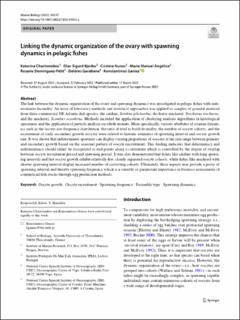| dc.description.abstract | The link between the dynamic organization of the ovary and spawning dynamics was investigated in pelagic fishes with indeterminate fecundity. Αn array of laboratory methods and statistical approaches was applied to samples of gonadal material from three commercial NE Atlantic fish species: the sardine, Sardina pilchardus, the horse mackerel, Trachurus trachurus, and the mackerel, Scomber scombrus. Methods included the application of clustering analysis algorithms in histological specimens and the application of particle analysis on whole mounts. More specifically, various attributes of ovarian dynamics such as the oocyte size frequency distribution, the ratio of total to batch fecundity, the number of oocyte cohorts, and the recruitment of early secondary growth oocytes were related to historic estimates of spawning interval and oocyte growth rate. It was shown that indeterminate spawners can display varying proportions of oocytes at the size range between primary and secondary growth based on the seasonal pattern of oocyte recruitment. This finding indicates that determinacy and indeterminacy should rather be recognized as end-points along a continuum which is controlled by the degree of overlap between oocyte recruitment period and spawning period. It was also demonstrated that fishes like sardine with long spawning intervals and fast oocyte growth exhibit relatively few, clearly separated oocyte cohorts, while fishes like mackerel with shorter spawning interval display increased number of coexisting cohorts. Ultimately, these aspects may provide a proxy of spawning interval and thereby spawning frequency which is a variable of paramount importance in biomass assessments of commercial fish stocks through egg production methods. | en_US |
